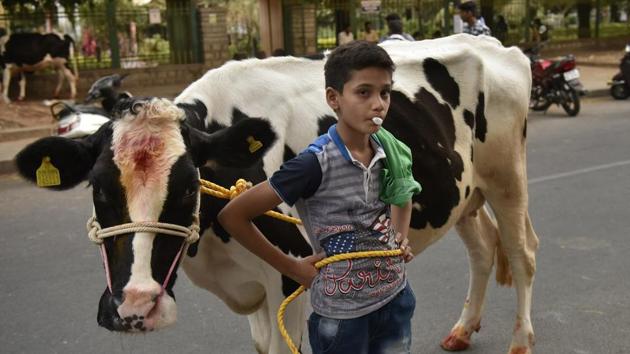Aadhaar-like tags for cows: Does govt’s intent match ground realities?
In a country where universal healthcare is yet to be achieved, can the government be accused of getting its priorities wrong in earmarking precious revenue for tagging cows? Also, does India have the infrastructure to tag and monitor the health and well-being of its 40 million dairy cattle and about 299 million bovine population across India?
Recently, Hermien, a cow in the Netherlands, became an Internet sensation after escaping from a trip to the abattoir and evading attempts to capture her for more than four weeks. News about her escape spread and soon groups formed to save Hermien, with even the royal family in the Netherlands supporting the cause. Finally about $60K was raised through crowd-funding and Hermien will now live happily ever after in a retirement home.

To protect Hermien-like bovines from illegal trade, to increase dairy productivity, to improve the health and number of local breeds, and also, thereby, increase farm income, the central government’s plans to give a 12-digit Aadhaar-like unique identification (UID) tag to cattle in India. In this year’s Union budget Rs 50 crore has been allotted to cover 40 million dairy cattle under the Pashu Sanjivini scheme.
Rs 50 crore sounds inadequate for a project as big as the one proposed by the government. However, with each tag costing about Rs 10, as reported by Hindustan Times, Rs 50 crore is enough for 40 million cattle. But is tagging enough to ensure health and safety of cattle?
It’s a given that cattle, or for that matter any animal, needs to be protected from illegal trade; and efforts towards this must be welcome. However, a part of the suspicion comes from the fact that the plan has been proposed by a government that has not kept under wraps its love for cattle. The protection of cows is an issue that has often taken political and even communal hues. Also the lawlessness in the past by self-styled gau-rakshaks, resulting in some instances in the murder of innocent people, leads to the feeling that this initiative could be misused.
Tagging cows to prevent their trafficking was an idea mooted by a government committee in 2015. In Jharkhand, the tagging is done by the Jharkhand State Implement Agency for Cattle and Buffalo (JSIACB) which acts as a nodal agency in the state to supplement the efforts of the department of animal husbandry.
An Aadhaar-like UID number for cows might raise many eyebrows, and sounds odd at first. However, full marks to the government for intent. But, intent alone is not enough. The intent behind setting up PHCs, taluk hospitals and medical college hospitals across India is that no one is denied access to healthcare. The intent behind setting up anganwadis, LP schools, high schools, colleges, and providing free education till the age of 14, etc, is that no child is denied the opportunity to learn. However, in reality, both cases are nowhere near achieving the intent it was set up for. Plagued by inadequate infrastructure, shortfall in resources and leaky systems, there’s much to be desired about healthcare and education in India. In a country where universal healthcare is yet to be achieved, can the government be accused of getting its priorities wrong in earmarking precious revenue for tagging cattle?
That leads to the question: Does India have the infrastructure to tag and monitor the health and well-being of its 40 million dairy cattle and about 299 million bovine population across India? Are India’s 45 veterinary colleges (according to Veterinary Council of India data) enough to meet the demand for trained practitioners for this task?
If it’s Hermien in the Netherlands, it’s a Gaurakshak Shaheed Samarak that’s generating a buzz in Haridwar. Situated in Katarpur village in Haridwar district, in Uttarakhand, the samarak is built to honour the death of four villagers who opposed the slaughter of cows during British rule in 1920. Efforts are now on to promote the village as a cow pilgrimage centre with state minister Dhan Singh Rawat promising to develop a huge cow memorial in the village.





